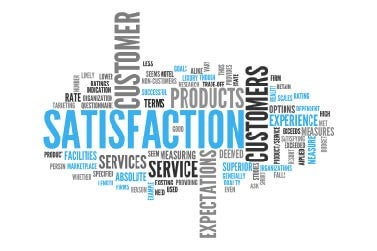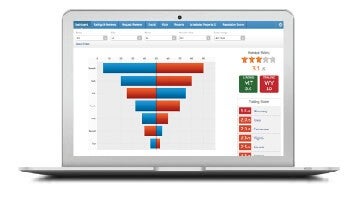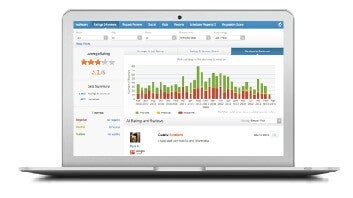Online Reputation Management Starter Series, Part 3: Taking Action on Customer Feedback
Reputation Staff Writer

Introduction
The voice of the customer is louder than ever — and you can no longer ignore it.
Online Reputation Management (ORM) helps you tune in and take action, providing valuable insights from online reviews, social media comments and customer satisfaction surveys.
In Part 1 of our ORM Starter Series, we provided valuable information and tips about defining your Online Reputation Management goals, focusing your efforts and securing executive buy-in.
In Part 2, we explored the highest-impact review sites — Google and Facebook — as well as a host of specialty sites in greater detail, to help you determine the best plan of action for maximum impact.
Here in Part 3, we’ll show you why surveys are a critical ORM strategy. With advanced analytics and reporting, an ORM platform can help you gain operational insights from customer feedback in surveys, and use those insights to improve the customer experience.
Surveys are a critical aspect of managing your reputation
Customer surveys are more than just a set of feel-good check-boxes. Great customer surveys can provide deep insight into what motivates, impresses or disappoints your customers, helping you to fine-tune the customer experience to attract and retain more business.
A well-designed survey enables you to:
- Assess service levels across all your locations.
- Uncover ways to improve service quality before customers write negative reviews.
- Build customer trust and advocacy.
According to Temkin Group, companies that are considered to be customer experience leaders have a 16 percent advantage over their competitors in key customer retention metrics — willingness to buy, reluctance to switch brands and likelihood to recommend. So, it’s critical to tune in and take action.
However, many companies struggle with developing surveys that do what they’re intended to do — provide actionable insight. And low response rates make it difficult to get a balanced picture of your overall performance.
“Companies that are customer experience leaders have more than a 16 percent advantage over competitors in willingness to buy, reluctance to switch brands, and likelihood to recommend.”
— Temkin Group
The Challenges of Collecting Feedback
For many companies, designing and sending engaging surveys that collect valuable, candid feedback is challenging. Here are some of the pitfalls:
- Surveys ask too many questions and require too big a time commitment from respondents. People either don’t bother to respond, or abandon the survey partway through because it takes too much time to complete.
- Surveys aren’t customized and ask questions that aren’t relevant to the respondent. Fields are left blank, and customers may feel as though you don’t understand them. This breaks trust and may be damaging to your reputation.
- Surveys are sent too late. If customers don’t receive a survey request soon after the transaction, they lose interest. Even if they respond, the details may be fuzzy. What you get is general, typically unusable feedback — if you get any feedback at all.
- Surveys are delivered in an inconvenient format. Capturing feedback requires reaching customers where they are — and making it easy for them to complete surveys.
No Goal? Your Customers Can Tell
If you don’t have a clear goal in mind for your survey, it will be obvious. The questions will not relate to each other or follow a logical sequence. The survey as a whole probably won’t be structured properly. You may fail to ask important questions, and you won’t get the information you need.
Such haphazard survey construction can create a bad customer experience — and result in low response rates, frustrated customers and loss of trust.
Done Well, Surveys Yield Actionable Feedback
To be effective, your customer surveys should have five key characteristics:
1. True to brand: Like all outward-facing customer communications, your surveys should reinforce your brand. Use this customer touchpoint as another way to establish a connection between your customer and your company. Generic surveys are suspicious and may deter customers from participating.
2. Customized: It’s important to customize the look, length and language of your survey to target the customer segment at hand. You may want to ask different questions depending on a demographic or the type of interaction the customer has had (in a store versus online, for example). Customization is another way to demonstrate that as a company you value your customers and are taking time to address their specific needs and expectations.
3. Multi-platform: It’s important to provide multiple ways for your customers to submit feedback. Today, surveys can be completed via email and text, in an app, and on a website. A recent survey found an estimated 30 to 40 percent of all online surveys are completed on a mobile device, and that number is growing. Consider your target audience and tailor your delivery method according to their preferences.
4. Effective at generating reviews: Surveys are a great way to request online reviews. If you send your survey via text, for example, you can follow up with a text requesting a review and providing a link to a major review site. An email-based survey can also include a review request and link. Customers are more likely to write a review if they’ve already committed to completing a survey. Plus, the great experience they’ve had with your company will still be fresh in their minds.
SMS-based Surveys
SMS-based surveys are gaining traction, because they provide a level of interaction not possible with other delivery methods. They can be programmed to ask different questions on the fly, depending on the customer’s responses, making the interaction highly conversational and engaging.
5. Actionable: The ultimate goal of surveys is to identify issues and opportunities, and provide directional guidance. Without a way to analyze and report on responses, your survey data is useless. ORM platforms that offer analytics and reporting features can help you glean actionable insights from survey responses, so you can quickly address problem areas and standardize on what’s working well.
Actionable Insights for a Better Customer Experience
Robust Online Reputation Management platforms apply sophisticated machine learning algorithms to free text and integrate a wide range of data sources to deliver actionable insights. Below are some advanced capabilities that enable organizations to use feedback from surveys and online reviews to elevate the customer experience.
- Thematic analysis: Thematic analysis can help organizations identify strengths and weaknesses in the way your locations interact with customers. For example, word clouds provide a visual representation of the words and phrases found in your feedback. The larger the word, the more often it shows up. You can drill down by clicking on words to read the complete review or response text, to get context for the comment.

Case In Point
One large healthcare organization was receiving critical feedback regarding a lack of parking at hospital facilities. They analyzed a word cloud that indicated “parking” and “find a spot” were common phrases in reviews and survey responses.
Sending follow-up, customized surveys through the Reputation.com platform, they learned that weak signage was the main issue. Once new signage was implemented, the problem was solved, and negative feedback subsided.
- Sentiment analysis: Sentiment analysis flags words that are associated with or related to troublesome keywords. For example, the word “reeked” will be grouped with “odor,” while “crowded” might be grouped with “wait times.” Such associations provide a more complete and accurate reflection of the customer’s experience.

- Competitive benchmarking: It’s important to understand how you’re performing relative to your competitors. Reputation.com’s Tornado Chart tool provides a clear picture of performance trends relative to industry benchmarks. You can compare customer sentiment about your locations in various categories against the average for competitors — at a glance.

- Insightful reporting: Once you’ve analyzed your customer feedback, the ability to schedule customized reports and deliver those reports to key internal stakeholders is critical. A robust ORM platform will provide an extensive library of report templates that can be customized to present data according to the needs of different groups within your organization. And you should be able to schedule and distribute reports automatically through the platform.
Need Help? Managed Services May Be the Answer
If you have a small team or one that’s really busy, you can outsource the ORM work to a managed services provider. This will save you time and resources while giving you the peace of mind that your online reputation is in capable hands.
Choosing the Right ORM Platform: What to Look For
To maximize your investment, you should qualify your options carefully and look for:
- A comprehensive solution with integrated capabilities that span all aspects of ORM.
- An automated platform that scales reliably across thousands of locations.
- Intuitive dashboards that provide at-a-glance insight.
- Analysis and reporting tools that provide actionable insights to improve customer experience.
Are you ready to get started? If so, contact us and we’ll help you plan your ORM strategy.
